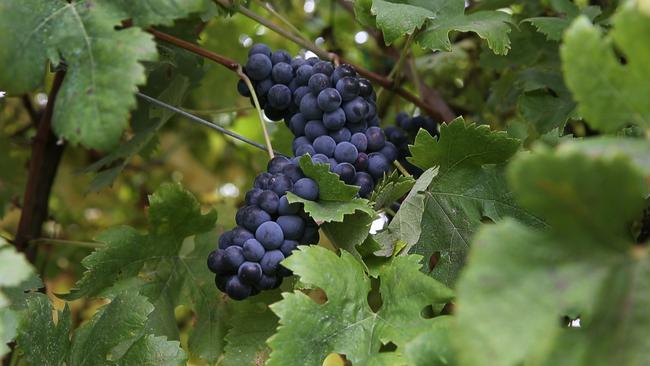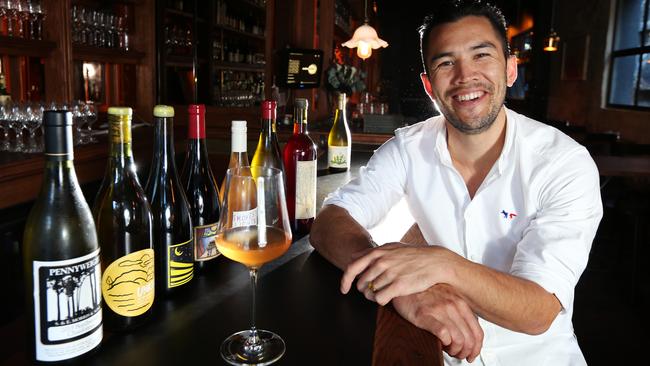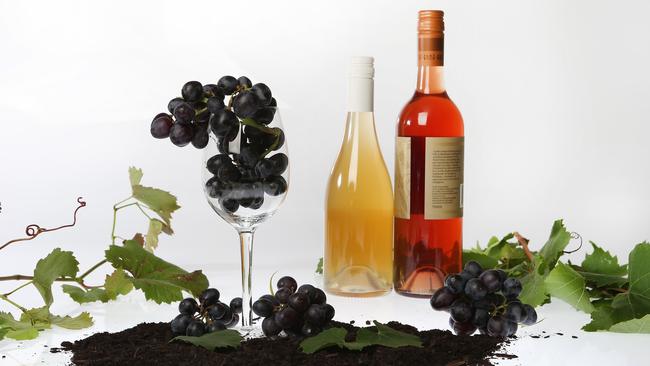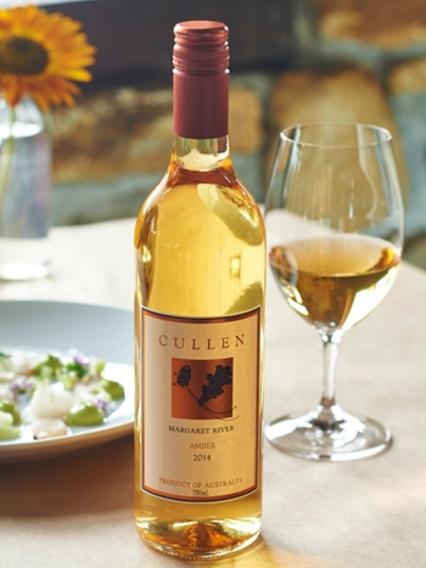Natural wine: your guide to the wine trend sweeping Australia
IT’S CALLED both the wine of the future and a flawed fad. Either way, the natural wine wave is washing over Australia.
Melb Food & Wine Festival
Don't miss out on the headlines from Melb Food & Wine Festival. Followed categories will be added to My News.
To its band of young believers, it’s wine of the future: fresh, lively and speaking the unadulterated truth of the land.
To its detractors, it’s lazy winemaking driven by dogma producing faulty, undrinkable wines that are faddish, flouting rules and conventions of wisdom, and taste.
But what is “natural” wine?

“Natural wine is wine produced from grapes that are organically or biodynamically farmed that are then processed in the winery with minimal intervention and without any additives that are at a modern winemaker’s disposal. It’s fermented naturally, and goes into the bottle with minimal or no sulphur,” says Mike Bennie, a co-founder of Rootstock Sydney, a three-year-old food and wine festival that focuses on natural wine and sustainable produce that draws up to 15,000 people each year.
Sounds perfectly good, so why is the established wine world up in arms?
Leaving fermenting grapes to “do their thing” can produce wines traditionally viewed as faulty: possessing volatile acids (which leaves the wine smelling like vinegar or nail polish remover), or brettanomyces (a naturally occurring yeast that gives wine “horsey”, “barnyard”, or “Band-Aid” smells).
IS THE FUTURE OF WINE UNDERWATER?
Natural wine is often cloudy, spritzy and can be stinky — and it’s taking over wine lists at cool restaurants and hip bars.

Natural wine is, of course, how grapes have been turned into good stuff for the best part of 6000 years. Up until about 50 years ago, when using chemicals to increase yield first became commonplace, organic was the only way.
The natural wine movement is a response, driven in the main by the Millennial generation, to industrial-scale farming practices and bland homogeny.
ORGANIC V BIODYNAMIC
“All biodynamic wine is organic, but not all organic wine is biodynamic,” explains Mike.
Biodynamics is an extension of organic farming that embraces Rudolph Steiner’s methods that take closed loop agriculture — using everything on the farm without waste — and adds a dash of the esoteric, including using moon, sun and planetary cycles to inform farming practises.
“It’s holistic, grand, somewhat mystical but also science-based process of growing things naturally,” Mike says.
This is said to result in better grapes that more truly reflect the land on which they were grown and, hopefully, better wine. Of course, Mike says, you can grow beautiful grapes organically and stuff them up in the winery. That’s up to the winemaker.

IS IT ALL BAD?
“A lot of people have had a bad experience with natural wines, and therefore think all natural wines are bad,” says Christian McCabe, co-owner and chief wine buyer for CBD bar Embla.
He likens the experience to eating organic food 15 years ago, when that, too, was the preserve of the counterculture — hippies, vegans. If you ate organic then it was likely to be in some ideological cafe consisting of little more than sloppy stewed beans and vegetable curries.
“If you judged this on being organic, rather than on the person not being able to cook, you might say that organic food sucks. It’s the same with natural wine.”
HOW TO EAT LIKE A LOCAL IN BOX HILL
YOUNG AND RESTLESS
Mike says the natural wine movement is driven by a curious and exploratory generation of wine drinkers, who are less concerned with classic wine learning and classic wine regions.
“The gatekeepers — the sommeliers, particularly, and to a lesser extent the wine writing community — have discovered the curiosity in exploring these wine styles.”
Christian agrees. “The culture of sommeliers and wine writing was a way of excluding people. Now it’s being turned around to an acknowledgment that wine was a peasant drink. It shouldn’t be something that has to be intellectualised.”

DOGMA VS DELICIOUS
For Christian, the choice is simple. “For me, it’s always about deliciousness. Ultimately, that’s what it’s all about.
“Separate the style of wine, from the actual viticultural dogma, in the same way you separate organic farming technique with all the philosophical and moral considerations of why you’d do that, versus good cookery.”
ARE NATURAL WINES “STORY DRIVEN”?
“Yes. There’s a fatigue with the complex language of wine in which random fruit descriptions and texture descriptions add to the confusion and alienation of the customer,” Mike says. “A story about the winemaker and the process makes a bit more sense.”
IS IT FAULTY?
“Many people say natural wine is faulty. Some is, as is some wine that’s produced anywhere in the world,” Mike says.
“There’s lots of denigration about natural wine without understanding it comes with a philosophical ethos that’s more about the purity, about just fermenting grapes, putting them in the bottle, and drinking them. There’s a new generation, a younger generation, who are embracing the expressive nature of natural wine, that other people might consider faulty.”
But a fault that’s too overt in a wine should be sent back. “A degree of brettanomyces can lend a savouriness to wine, too much makes it revolting,” Mike says. “A degree of volatility can lend a freshness, a zingy tang to a wine, too much and it tastes like vinegar.”

WHAT IS ORANGE WINE?
Basically, orange wine is just white wine made like red wine. It means the white grapes are fermented with their skins, rather than the juice and skin being separated. While orange wine isn’t a natural wine by virtue of being orange, many natural winemakers have been experimenting with this style around the world.
“Orange wine is more textural, more aromatic, than traditional white wine,” Mike says.
WHY USE AMPHORA?
In keeping with the overriding ethos of minimal intervention, many natural winemakers are fermenting their wines in clay or terracotta amphora.
“New oak creates a strong flavour in wine that detracts from the appreciation of where and how the grapes were grown,” Mike says.
“Amphora provides a neutral base for grapes to sit in and reflect more clearly the growing season.”
WHAT IS “PET-NAT”?
Another term you’ll see heading up natural wine lists, petillant-naturel, usually shortened to “pet-nat”, is naturally sparkling wine. Still fermenting grape juice is bottled and sealed, where the fermentation continues, creating C02 that then dissolves into the wine.
SULPHUR, SO WHAT?
Sulphur dioxide is widely added to modern wine as a preservative, as it has both antioxidant and antimicrobial properties. Though all wine contains some SO2 (it’s a byproduct of fermentation), most natural wines aim for low or no sulphur.
“Some people think no sulphur should be added,” Mike says. “Low sulphur is part of the (natural) mantra, as too much can detract from the wine.”
WHAT DO THEY TASTE LIKE?
For Mike, when it comes to enjoying natural wines it’s less about identifying fruit flavours and more about texture.
“There’s a refreshment factor, the young fresh wines are very thirst slaking. You want to drink them like a juice. They’re wines that suit Australia better. These are the wines we drink in parks at midday, or with our legs dangling in the pool.
“They match our love of Mediterranean cuisine and the seafood bounty outside our capital cities. Asian cuisine, spice, salads, grilled meats — these wines suit it all.”
GIVE IT A GO
Latta Wines out of Ballarat, Cowbaw Ridge in Macedon, Chevre Wines from the Otway Ranges, and Unkle wines are four local labels that Mike suggests trying. As well as the wines of Patrick Sullivan.

MEET YOUR MAKER
“It’s not about intimidating people, not about people saying I know something you don’t. It’s about drinking things that are delicious,” says Gippsland winemaker Patrick Sullivan, whose name, though he shies away from the term, has been indelibly linked to natural wine here.
“The best thing about the natural wine movement is that it hasn’t alienated people,” he says. “You don’t have to be an expert to know what’s good or not. People are drinking these fruit-forward wines and really enjoying drinking them because they taste like fruit.”
Patrick says he has two main groups of fans of his wines — those aged under 30, and women aged 40-60 who might not have drunk much wine in the past, put off by big chardonnay or oaky shiraz.
“Until about five years ago, people weren’t really drinking wine and were put off by it. Young kids now are into it and drinking wine. When have young people been drinking wine over beer? That’s so good to see.”
Patrick has created two wines exclusively for the Melbourne Food and Wine Festival. From a dry-grown, 40-year-old vineyard in Neerim South, he has made a pinot noir called Volcan Springs. It joins a chardonnay-pinot gris blend called Ada, both of which will be poured on tap at the House of Food and Wine, the hub of the 10-day festival.
DO THIS
As part of the Melbourne Food and Wine Festival, Sydney’s Rootstock will make its Melbourne debut at the festival’s House of Food and Wine on April 8. Hosted by founders Mike Bennie, Giorgio di Maria and James Hird, chefs including David Moyle (Longsong), Analiese Gregory (Bar Brose) and Aaron Turner (Igni) will join winemakers Gareth Belton (Gentle Folk), James Erskine (Jauma Wine), Owen Latta (Eastern Peake) and more in a celebration of organic/sustainable produce and naturally grown and made wines. Tickets: mfwf.com.au
OPENING OURS
Taste wine writer Tony Love’s take on natural wine
Let’s start with the word itself: natural.
When it became a thing in wine there was an immediate reaction from the Australian wine industry old guard, producers and commentators. The word has a pejorative sting in its seemingly clean, green tail. If the wine from such a ragtag bunch of L-plate blow-ins was “natural” then what did that say about all the rest?
Not surprisingly, there was a “how dare they” moment that grew to wider resentment of the new bushrangers shaking the ground where a generation of highly trained, worldly wine professionals had forged their reputation on technically sound drinks that if anything negative was to be thrown at them, it was about their uniformity and predictability.

The time perhaps was right for a breath of fresh air as the generations changed. For the traditionalists however, that breath was often odorous.
Many would have agreed with wine commentator Phillip White, who recently called the worst of them “murky hippie wines the colour of Donald Trump’s hair and as biologically mucked up and challenging as his brain”.
The new wave winemakers may have wanted to disrupt the old order, but their experiments disgusted the classicists.
However, it wasn’t long before those first mavericks were accepted.
But the noise this small band of upstarts generates grates many mainstream producers, given that the new kids are so few and their volumes minuscule.
The adoration of these wines and their makers by a sympathetic squad of new generation restaurateurs and sommeliers, including the world famous Noma last year in their Sydney pop-up, has not only legitimised the genre but baffled the traditionalists.
Similarly, the largest new sector of wine fans, the so-called millennials, have jumped onto the natural wine train with abandon — everything the new school stands for speaks their language. It’s not what grandad drank. It’s artisan made from a homegrown business.
It’s the reasoning that makes the movement so hip, even if a lot of the wines wouldn’t pass muster from entry level judging to international competition standards.
But as the experience of the mavericks broadens, so do their wines improve, though there is a appley cider-esque sameness to many in the fresh, drink now, raw wine genre that contradicts the mantra that such wines show their sense of place.
Despite all the angst, the naturalists are here to stay. They’re a marketing dream for a new generation, even for the industry’s peak body, Wine Australia, seeking to put excitement into often jaded consumers.
